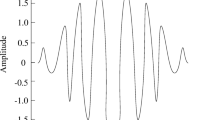Abstract
Radar target signals and chaff cloud jamming signals have different characters by the wavelet transform. The wavelet coefficients of radar target signals are highly correlated with its near-and-near-scale wavelet coefficients, however the correlativity between the wavelet coefficients of chaff cloud jamming signals and its near-and-near scale wavelet coefficients is less significant. Based on the binary-base discrete wavelet transform and the correlation algorithm, the method of target entropy to estimate standard variance of the jamming signals and each scale is proposed to ensure reasonable threshold, to suppress chaff cloud signals and finally to reconstruct mixed signals by the improved spatially selective noise filtration (ISSNF) method. The extensive simulation results show that the proposed method can availably suppress chaff cloud jamming and decontaminate target echo.
Similar content being viewed by others
References
Guo Y, Uberall H. Bistatic radar scattering by a chaff cloud [J]. IEEE Transactions on Antennas and Propagation, 1992, 40(7): 837–841.
Macedo A D F. Analysis of chaff cloud RCS applying fuzzy calculus [C] // Proceedings of Microwave and Optoelectronics Conference. Natal, Brazil: IEEE, 1997: 724–728.
Marcus S W. Dynamics and radar cross section density of chaff clouds [J]. IEEE Transactions on Aerospace and Electronic Systems, 2004, 40(1): 93–102.
Feng You-qian, Zhang Shan-wen, Song Guo-xiang. A method for recognition of radar targets under chaff jamming based on the wavelet [J]. Journal of Xidian University, 2003, 30(3): 345–348 (in Chinese).
Li Wei-min, Shi Zhi-guang, Fu Qiang. Modeling and simulation of signature of shiptargets [J]. Journal of System Simulation, 2005, 17(9): 2047–2050 (in Chinese).
Lutsenko V I, Homenko S I, Roenko A N. Backscattering spectral and polarization features of the surface targets in centimeter and millimeter waves ranges [C] // The Fourth International Kharkov Symposium on Physics and Engineering of Millimeter and Sub-Millimeter Waves. Kharkov, Ukraine: IEEE, 2001: 405–407.
Cloude S R, Pottier E. A review of target decomposition theorems in radar ploarimetry [J]. IEEE Transactions on Geoscience and Remote Sensing, 1996, 34(2): 498–518.
Sun Yan-kui. Wavelet analysis and its application [M]. Beijing: China Machine Press, 2005 (in Chinese).
Author information
Authors and Affiliations
Corresponding author
Additional information
Foundation item: the Defense Pre-research Subject of China (No. 51473030101JW0301)
Rights and permissions
About this article
Cite this article
Zhao, Hb., Pei, Jz., Zhao, Lm. et al. Chaff cloud jamming suppression based on wavelet transform. J. Shanghai Jiaotong Univ. (Sci.) 16, 704–707 (2011). https://doi.org/10.1007/s12204-011-1214-4
Received:
Published:
Issue Date:
DOI: https://doi.org/10.1007/s12204-011-1214-4
Key words
- wavelet transform
- target entropy
- improved spatially selective noise filtration (ISSNF)
- jamming suppression




